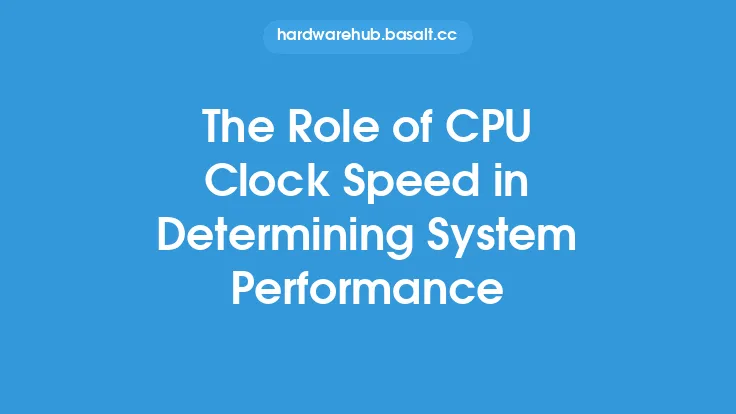The central processing unit (CPU) is a crucial component of any computer system, responsible for executing instructions and handling tasks. At the heart of the CPU are its cores, which play a vital role in determining the overall performance of the system. In this article, we will delve into the world of CPU cores and explore their significance in improving system performance.
Introduction to CPU Cores
A CPU core is the primary processing unit of a CPU, responsible for executing instructions and handling tasks. It is the brain of the CPU, where all the calculations and data processing take place. A single core can handle only one task at a time, but with the advent of multi-core processors, modern CPUs can handle multiple tasks simultaneously, leading to significant improvements in system performance. The number of cores in a CPU can vary, ranging from dual-core to hexa-core, octa-core, and even more.
How CPU Cores Improve System Performance
The presence of multiple CPU cores in a system can significantly improve its performance in several ways. Firstly, with multiple cores, the system can handle multiple tasks concurrently, reducing the time it takes to complete tasks and improving overall productivity. This is particularly useful in applications that require simultaneous execution of multiple threads, such as video editing, 3D modeling, and scientific simulations. Secondly, multiple cores can help to reduce the load on individual cores, preventing overheating and improving overall system stability. Finally, with more cores, the system can take advantage of parallel processing, where tasks are divided into smaller sub-tasks and executed simultaneously, leading to significant performance gains.
CPU Core Architecture
The architecture of CPU cores is designed to optimize performance, power consumption, and area efficiency. Modern CPU cores are based on the pipelined architecture, which allows for the execution of multiple instructions in a single clock cycle. The pipeline consists of several stages, including instruction fetch, decode, execute, and store, each of which is responsible for a specific task. The pipeline architecture allows for the execution of multiple instructions in parallel, improving overall performance. Additionally, modern CPU cores often feature advanced technologies such as out-of-order execution, speculative execution, and branch prediction, which help to improve performance by reducing the number of idle cycles and improving instruction-level parallelism.
CPU Core and Thread Scheduling
The scheduling of CPU cores and threads is a critical aspect of system performance. The operating system is responsible for scheduling threads on available CPU cores, ensuring that each core is utilized efficiently. There are several scheduling algorithms used in modern operating systems, including the First-Come-First-Served (FCFS) algorithm, the Shortest Job First (SJF) algorithm, and the Round Robin (RR) algorithm. Each algorithm has its strengths and weaknesses, and the choice of algorithm depends on the specific requirements of the system. Additionally, modern operating systems often feature advanced scheduling techniques, such as thread prioritization, affinity scheduling, and dynamic voltage and frequency scaling, which help to optimize system performance and power consumption.
Hyper-Threading and Multi-Threading
Hyper-threading and multi-threading are technologies that allow a single CPU core to execute multiple threads simultaneously. Hyper-threading, also known as simultaneous multi-threading (SMT), is a technology developed by Intel that allows a single core to execute two threads simultaneously. Multi-threading, on the other hand, is a programming technique that allows a single application to execute multiple threads simultaneously. Both hyper-threading and multi-threading can improve system performance by increasing the number of threads that can be executed simultaneously, but they also introduce additional complexity and overhead, which can negatively impact performance if not managed properly.
CPU Core Overclocking and Underclocking
CPU core overclocking and underclocking are techniques used to modify the clock speed of CPU cores to improve system performance or reduce power consumption. Overclocking involves increasing the clock speed of CPU cores beyond their rated speed, while underclocking involves reducing the clock speed below the rated speed. Overclocking can improve system performance by increasing the number of instructions that can be executed per second, but it also increases power consumption and heat generation, which can reduce the lifespan of the CPU. Underclocking, on the other hand, can reduce power consumption and heat generation, but it also reduces system performance. Both overclocking and underclocking require careful tuning and monitoring to ensure that the system remains stable and reliable.
Conclusion
In conclusion, CPU cores play a vital role in improving system performance. The presence of multiple CPU cores can significantly improve system performance by allowing for the execution of multiple tasks simultaneously, reducing the load on individual cores, and improving overall system stability. The architecture of CPU cores is designed to optimize performance, power consumption, and area efficiency, and features advanced technologies such as pipelining, out-of-order execution, and branch prediction. The scheduling of CPU cores and threads is a critical aspect of system performance, and modern operating systems feature advanced scheduling techniques to optimize system performance and power consumption. Hyper-threading and multi-threading can also improve system performance by increasing the number of threads that can be executed simultaneously, but require careful management to avoid additional complexity and overhead. Finally, CPU core overclocking and underclocking can be used to modify the clock speed of CPU cores to improve system performance or reduce power consumption, but require careful tuning and monitoring to ensure system stability and reliability.





